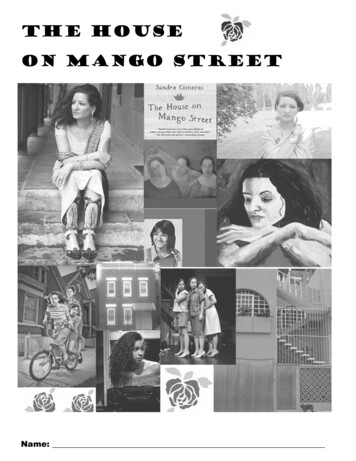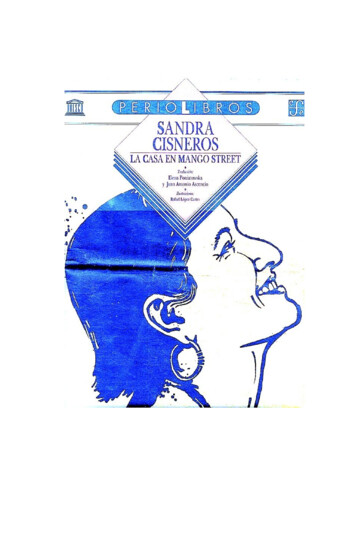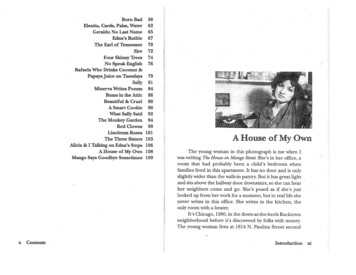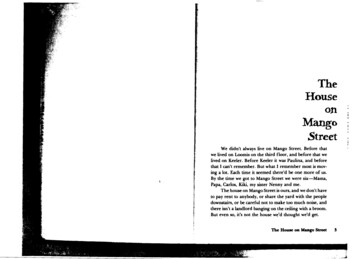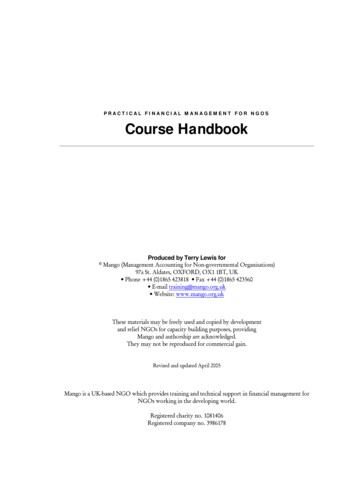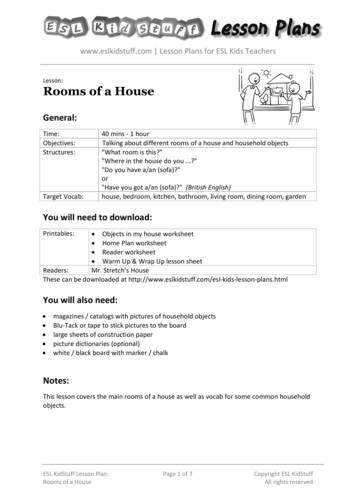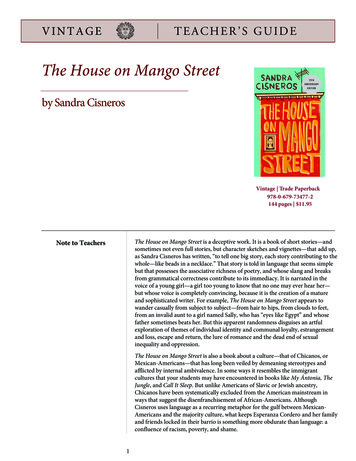
Transcription
VINTAGETEACHER’S GUIDEThe House on Mango Streetby Sandra CisnerosVintage Trade Paperback978-0-679-73477-2144 pages 11.95The House on Mango Street is a deceptive work. It is a book of short stories—andsometimes not even full stories, but character sketches and vignettes—that add up,as Sandra Cisneros has written, “to tell one big story, each story contributing to thewhole—like beads in a necklace.” That story is told in language that seems simplebut that possesses the associative richness of poetry, and whose slang and breaksfrom grammatical correctness contribute to its immediacy. It is narrated in thevoice of a young girl—a girl too young to know that no one may ever hear her—but whose voice is completely convincing, because it is the creation of a matureand sophisticated writer. For example, The House on Mango Street appears towander casually from subject to subject—from hair to hips, from clouds to feet,from an invalid aunt to a girl named Sally, who has “eyes like Egypt” and whosefather sometimes beats her. But this apparent randomness disguises an artfulexploration of themes of individual identity and communal loyalty, estrangementand loss, escape and return, the lure of romance and the dead end of sexualinequality and oppression.Note to TeachersThe House on Mango Street is also a book about a culture—that of Chicanos, orMexican-Americans—that has long been veiled by demeaning stereotypes andafflicted by internal ambivalence. In some ways it resembles the immigrantcultures that your students may have encountered in books like My Ántonia, TheJungle, and Call It Sleep. But unlike Americans of Slavic or Jewish ancestry,Chicanos have been systematically excluded from the American mainstream inways that suggest the disenfranchisement of African-Americans. AlthoughCisneros uses language as a recurring metaphor for the gulf between MexicanAmericans and the majority culture, what keeps Esperanza Cordero and her familyand friends locked in their barrio is something more obdurate than language: aconfluence of racism, poverty, and shame.1
It may help your discussion to remind students that the ancestors of manyChicanos did not come to the United States by choice, but simply found themselvesin alien territory as a result of the U.S.’s expansionist policy into country that hadonce been Mexican.But although The House on Mango Street will have a particularly strong appeal toLatino students, who may never have encountered a book that speaks so pointedlyto their own experience, it is a work that captures the universal pangs of otherness—what Cisneros, in her introduction to the tenth anniversary edition (published byKnopf, 18.00), has called “the shame of being poor, of being female, of being notquite-good-enough.” It suggests from where that otherness comes and shows howit can become a cause for celebration ra-ther than shame. Few students, regardlessof their ancestry or gender, will come away from this book without a strongsensation of having glimpsed a secret part of themselves. For, as Sandra Cisneroshas written, “You, the reader, are Esperanza. . . .You cannot forget who you are.”Teaching IdeasThe questions, exercises, and assignments that follow are designed to guide yourstudents through The House on Mango Street and to help them approach it as both awork of literature and a window into their own lives. They are divided into sectionsthat test reading comprehension, invite in-class discussion, and suggest avenues ofindependent study and writing. Students should be encouraged to keep journals inwhich they record their responses to the work, pose questions for the teacher, and takenotes for their written assignments. We feel that The House on Mango Street isespecially valuable as an occasion for students to think and write about their ownexperience: their houses, their families, their neighborhoods, their dreams anddisappointments, about the way they relate to the other sex, about the kinds of livesthey want and the kinds they fear they may end up living. It is a book that invitesempathy, as well as critical intelligence. At different points in your discussion you maywant to ask your students about the different feelings Esperanza’s story calls forth,paying particular attention to the different ways in which girls and boys respond to it.Discussion and WritingI. Comprehension1. Where did the narrator live before she moved to the house on Mango Street?How were her previous homes different?2. In what kind of house would she like to live? Does her new home live up to herexpectations? Why not?“Hairs”3. Who are the members of Esperanza’s family?“My Name”4. After whom was Esperanza named? What does her namesake’s story tell you aboutthe status of women in Mexican society?“Cathy Queen of Cats”5. Why is Cathy’s family about to move?"Our Good Day"6. How does Esperanza make friends with Lucy and Rachel? What makes them betterfriends than Cathy?“Marin”7. Who is Marin? Why is she unable to leave her house? How does she plan to changeher situation? Why do Esperanza and her friends admire her?2
“Those Who Don’t”8. How do outsiders see Esperanza’s neighborhood? How does Esperanza feelwhen she visits other neighborhoods?“There Was an Old Woman She Had So Many Children She Didn’t Know What toDo”9. Why does Rosa Vargas cry every day? Why do her children misbehave? Whathappens to her son Angel?“Alicia Who Sees Mice”10. How does Alicia's father treat her efforts to get an education?“The Family of Little Feet”11. What happens to Esperanza when she and her friends are given some cast-offshoes? How do the shoes change them? What effect do they have on the men in theneighborhood?“A Rice Sandwich”12. Why does Esperanza want to eat in the school canteen? How does she get hermother to help her?“Hips”13. What are the girls doing as they talk about hips? What are hips good for? Whatdoes their conversation tell you about their ages?“The First Job”14. Why does this story have a misleading title? What happens to Esperanza on herfirst day at work? What does this episode tell you about her family and theirexpectations?“Papa Who Wakes Up Tired in the Dark”15. Why does Esperanza’s father cry? How does his crying make her feel?“Born Bad”16. What happens to Aunt Lupe? Why does Esperanza believe she deserves to go tohell? What special relationship did Esperanza have with her aunt?“Geraldo No Last Name”17. Why does Geraldo have no last name? From the information Cisnerosprovides, do you believe that his death was inevitable?“Sire”18. Why is Esperanza afraid of Sire? What do her parents think of him? Why is sheso curious about what he does with Lois, and why does this curiosity make her feelas though “everything is holding its breath inside me” [73]?“No Speak English”19. What eight English words—or, really, phrases—does Mamacita know? Whatdo they tell you about the ways in which Mexican immigrants relate to the“official,” English-speaking culture outside their communities?“Rafaela Who Drinks Coconut & Papaya Juice on Tuesdays”20. What is making Rafaela grow old? Who was Rapunzel, and why would Rafaeladream of having hair like hers?3
“Sally”21. Describe the relationship between Sally and her father. How do herschoolmates see her? What transformation takes place when Sally comeshome?“Minerva Writes Poems”22. Why does Minerva write poems? Why is she black and blue when shecomes to visit Esperanza?“Bums in the Attic”23. What does Esperanza’s father do for a living? Why has Esperanza stoppedjoining her family on their Sunday outings?“Beautiful & Cruel”24. What is the nature of Esperanza’s “quiet war” [89]? Against whom—orwhat—is she fighting?“A Smart Cookie”25. How would you categorize the things Esperanza’s mother knows? Whatthings might she not know that Esperanza does? Why do you think she leftschool?“The Monkey Garden”/”Red Clowns”/”Linoleum Roses”26. How does the Monkey Garden change? What does Sally do that makesEsperanza so angry? From whom is she trying to save her? What eventuallyhappens to Sally? How does Esperanza feel about her marriage?“The Three Sisters”27. How does Esperanza meet the three sisters? What kind of future do theypredict for her? What is the responsibility they place on her?“Mango Says Goodbye Sometimes”28. How does the ending of The House on Mango Street complete a circle?II. Language: image, metaphor, and voice1. Throughout the book Cisneros has Esperanza employ common idiomaticphrases that serve as a kind of shorthand. Analyze some of the followingphrases and suggest what Esperanza means by them—and what the authormeans to tell us about Esperanza herself:a) “But I know how those things go.” [5]b) “people like us” [13]c) “We take what we can get and make the most of it” [33] d) “Ain’t it ashame” [66] e) “Same story” [85]2. In the story “Hairs,” Esperanza describes her mother’s hair as being “likelittle candy circles all curly and pretty.” [6] What does this metaphor, andthose in the next paragraph, suggest about Esperanza’s feelings for hermother? Where else in the book do metaphor and simile convey informationabout the narrator as well as about the person or thing she describes?4
3. In “Gil’s Furniture Bought and Sold,” Cisneros describes the sound of an oldmusic box: “It’s like all of a sudden he let go a million moths all over the dustyfurniture and swan-neck shadows in our bones.” [20] This technique, in which asound is described in terms of things seen and felt, is called synesthesia. Whereelse in the book does Cisneros use synesthesia? Write descriptions of: a) a place,using sounds; b) a piece of music, using smells; c) a meal, using colors; d) aperson, using taste and touch.4. In “Boys & Girls,” Esperanza describes herself as “a balloon tied to ananchor.” [9] What are the connotations of this metaphor, and what does it tellyou about Esperanza? Where else in the book does Cisneros use images andmetaphors associated with the sky? What ideas do these recurring images evoke?Where else does Sandra Cisneros use related images to suggest complicatedthemes?5. In “Chanclas,” an embarrassed Esperanza declines her cousin’s invitation todance, because her feet “are growing bigger and bigger.” What Cisneros isdescribing is not a literal reality but a feeling that in turn suggests other feelings.In this case, the sensation in Esperanza’s feet tells us about her selfconsciousness and embarrassment. Where else does the author use thistechnique? Describe the following situations in terms of the sensations theymight evoke in different parts of your body:a) entering a dark basementb) seeing a pet diec) learning that someone you secretly care for also likes youd) making a speech at your high school graduatione) seeing a baby brother or sister for the first time.6. The last sentence of the book is: “For the ones who cannot out.” [110] Strictlyspeaking, the sentence is ungrammatical, since “out” is not a verb. Why do youthink Cisneros has chosen to break perceived rules of grammar here? Might therebe any relation between “breaking” grammar and breaking out of Mango Street?III. The people on Mango Street1. How old do you think Esperanza is? Where in the book does Cisneros suggesther age?2. Of what is Esperanza ashamed?3. What makes her cry?4. What makes her angry?5. Why do you think Cisneros tells the reader about Esperanza’s house before shewrites about her name? Why is where Esperanza lives more important than whoshe is?6. How does she feel about the men in “The Family of Little Feet,” “Chanclas,”“The First Job,” “Sire,” and “The Red Clowns”?7. Throughout The House on Mango Street, Cisneros’s narrator describes herselffrom two points of view: as she sees herself and as she believes others see her. Wecan find an example of this in “My Name”: “At school they say my name funny asif the syllables were made out of tin and hurt the roof of your mouth.” [11] Whereelse in the book does Cisneros convey this dual consciousness? How doesEsperanza see herself? How does she think other people perceive her?5
8. Although Esperanza is clever and often very perceptive, she is still a child,and Cisneros sometimes shows her failing to see the significance of things thatwould be obvious to someone older. An example can be found on pages 24-5,when Esperanza and her friends take a ride in a flashy car driven by Louie'scousin, who is promptly arrested by the police. An adult might be suspiciousabout the new car and would probably not wave so cheerfully when Louie wastaken away. What is the effect of making Esperanza what is sometimes called an“unreliable narrator”? Where else in the story does Cisneros use this technique?9. At the novel’s end, Esperanza declares that she is too strong for Mango Streetto keep her forever. What is the nature of her strength? How does Cisnerosestablish this characteristic elsewhere in the book?10. What is the significance of the information in so many of the chapter titles,i.e., “Alicia Who Sees Mice,” “Papa Who Wakes Up Tired in the Dark,”“Minerva Writes Poems”? How important is this information to your sense ofwho these people are? What other details does Cisneros use to establish them?How would your sense of these people change had the author employed otherdetails—how they look, what they wear, what they do for a living?belonging; going away and coming back1. After rereading the chapters “The House on Mango Street,” “Bums in theAttic,” and “A House of My Own,” write a description of Esperanza’s house.How does she feel about it? How do you think her house might look to astranger? In what kind of house would she like to live?2. In “Boys and Girls” [8-9], Cisneros writes, “The boys and the girls live inseparate worlds.” In “Beautiful & Cruel,” there is the declaration “I havedecided not to grow up tame like the others who lay their necks on thethreshold waiting for the ball and chain.” [88] How would you describe therespective worlds in which Cisneros’s boys and girls live? What kind of menand women are they likely to become when they grow up? How would you sumup the book’s depiction of relations between the sexes? Use incidents anddescriptions in such stories as “My Name,” “Marin,” “Alicia Who Sees Mice,”“Rafaela Who Drinks Coconut and Papaya Juice on Tuesdays,” “Sally,”“Minerva Writes Poems,” “Beautiful & Cruel,” “Sally Says,” and “The MonkeyGarden.”3. Esperanza describes a number of women as possible role models: Marin[26-7], Alicia [31-2], Sire’s girlfriend Lois [72-3], Sally [81-3, 92-8]. What doesshe admire about these women? What things can they teach her?4. In the stories “My Name” and “No Speak English,” Cisneros describes a gulfbetween two languages, a gap of meaning and of feeling. In English, forexample, Esperanza means hope; in Spanish, says the narrator, it suggestssadness and waiting [10]. How does Esperanza feel about her two languages—and by extension, about her two cultures? How does she feel about the societyoutside her barrio? Look particularly at the chapters “Cathy Queen of Cats,”“Those Who Don’t,” “Papa Who Wakes Up Tired in the Dark,” “Geraldo NoLast Name,” and “Bums In the Attic.”5. When Esperanza visits Elenita to have her fortune told, the witch tells herthat she sees “an anchor of arms” and “a home in the heart.” What is thepossible significance of these visions? How do they tie in to themes Cisnerosdevelops elsewhere in the book?6
6. Nearly all the characters in Cisneros’s book dream of escaping. What do theywant to leave? Describe the ways in which different people try to escape, as well asthe result of their efforts. Do you think that Esperanza’s dreams of escaping arelikely to be more successful? How does being poor—as most of these charactersare—affect one’s chances of escaping a dead-end neighborhood or fulfilling otherdreams?7. Aunt Lupe tells Esperanza that writing “will keep you free.” In what way canwriting be an avenue of freedom? What does freedom mean to you? What activitygives you a sense of freedom?8. The three sisters tell Esperanza, “When you leave you must remember to comeback for the others.” What do they mean by this? In what way does Esperanzareconcile her longings to escape Mango Street with her loyalty to her origins?How might a writer like Cisneros come to terms with leaving a place like MangoStreet? How would you choose to remain faithful to a place you needed to leave?Beyond the Book1. Write a description of your home, using language that tells the reader both howit looks and how you feel about it. Then write a description of the kind of house inwhich you'd like to live.2. Read “Hairs,” “Laughter,” “Papa Who Wakes Up Tired in the Dark,” and “BornBad,” paying special attention to the language with which Esperanza describes themembers of her family. Then write a description of your own family, usingmetaphors that not only tell the reader what your relatives look like but thatsuggest how you feel about them.3. After rereading the story “My Name,” write about your own name. Who gave itto you? What language does it come from? What does your name originallymean? If you were named after someone in your family, tell a story about thatperson. How well does your name “fit” you? If you were going to rename yourself,what name would you choose and why?4. Esperanza describes the “Four Skinny Trees” as “four who do not belong herebut are here.” [74] How does this description reflect her own sense of herself?Where else in the book does Cisneros explore her heroine’s feelings ofestrangement? Write a description of an object in your neighborhood that reflectsyour feelings about yourself.5. Cisneros offers one view of Chicano culture in The House on Mango Street—theview her main character sees from her street in Chicago. How does this view ofChicano culture fit into the larger social fabric of the United States? Whatceremonies and values set it apart? What value does it ascribe to women? Drawingon independent research, present a different—or a more detailed—view of thisculture.6. How might The House on Mango Street be different if the narrator were a boy?7. How is the book similar to or different from other books you may have readthat feature young narrators, for example, young narrators, for example, Catcherin the Rye, Ellen Foster, or The Adventures of Huckleberry Finn?7
Sandra Cisneros is a poet, short story writer, novelist and essayist whose workexplores the lives of the working-class. Her numerous awards include NEAfellowships in both poetry and fiction, the Texas Medal of the Arts, a MacArthurFellowship, several honorary doctorates and national and international bookawards, including Chicago’s Fifth Star Award, the PEN Center USA LiteraryAward, and the National Medal of the Arts awarded to her by President Obama in2016. Most recently, she received the Ford Foundation’s Art of ChangeFellowship, was recognized among The Frederick Douglass 200, and was awardedthe PEN/Nabokov Award for Achievement in International Literature.About This AuthorHer classic, coming-of-age novel, The House on Mango Street, has sold over sixmillion copies, has been translated into over twenty languages, and is requiredreading in elementary, high school, and universities across the nation.In addition to her writing, Cisneros has fostered the careers of many aspiring andemerging writers through two non-profits she founded: the Macondo Foundationand the Alfredo Cisneros del Moral Foundation. She is also the organizer of LosMacArturos, Latino MacArthur fellows who are community activists. Her literarypapers are preserved in Texas at the Wittliff Collections at Texas State University.Sandra Cisneros is a dual citizen of the United States and Mexico and earns herliving by her pen. She currently lives in San Miguel de Allende.This teacher’s guide was written by Peter Trachtenberg. Peter Trachtenberg hastaught writing and literature at the New York University School of ContinuingEducation, the Johns Hopkins University School of Continuing Education, andthe School of Visual Arts.About This GuideCOPYRIGHTCopyright 1994 by VINTAGE BOOKS8
Teacher’s Notes9
FREE TEACHER’S GUIDES AVAILABLE FROM KNOPF DOUBLEDAYKnopf Doubleday is pleased to offer educators free Teacher’s Guides. You can mail your request to Knopf DoubledayAcademic Services, 1745 Broadway, 12–1, New York, NY 10019, fax us at (212) 572-2662, or e-mail your request toacmart@penguinrandomhouse.com.Penguin Random House Teacher’s Guides are also available on the web at penguinrandomhouseeducation.comVisit our website for highschool educators at prhsecondaryed.comand for college or university professors at prhhighered.com
The House on Mango Street is a deceptive work. It is a book of short stories—and sometimes not even full stories, but character sketches and vignettes—that add up, as Sandra Cisneros has written, “to tell one big story, each story contributing to the whole—like beads in a ne
